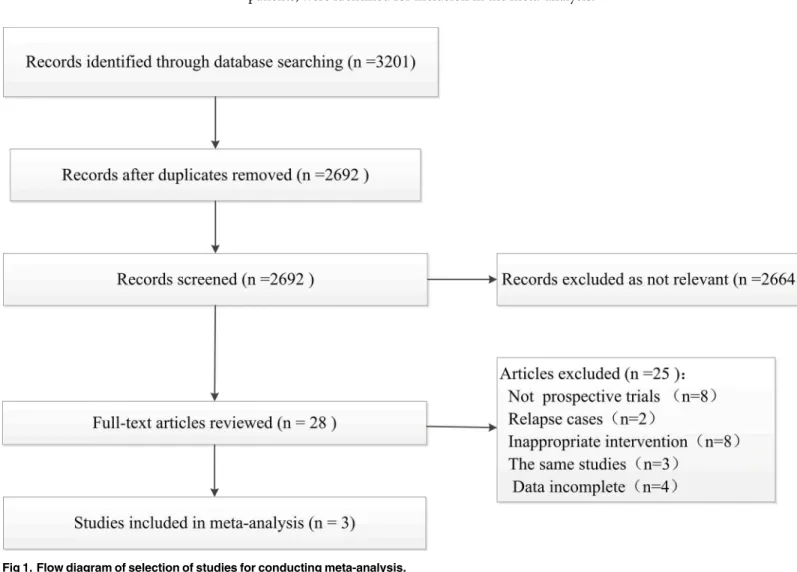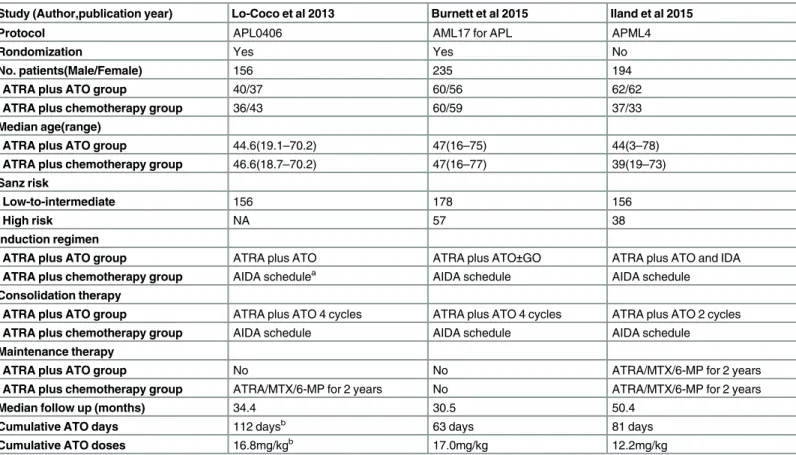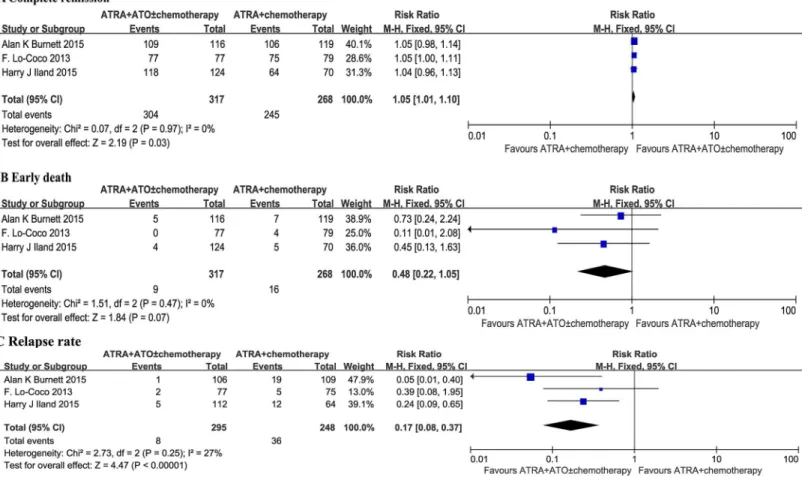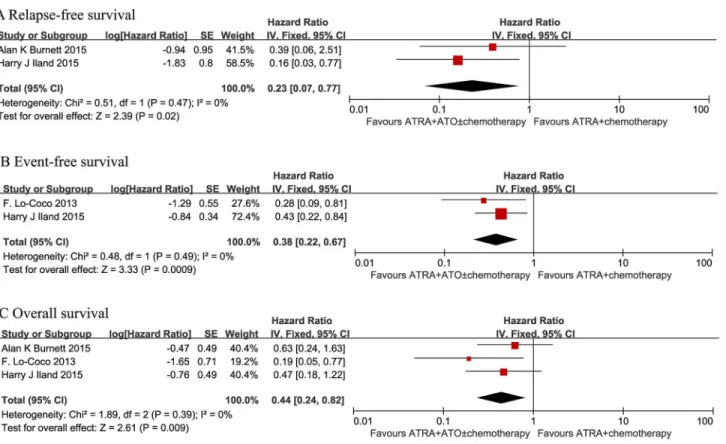All-Trans Retinoic Acid plus Arsenic Trioxide
versus All-Trans Retinoic Acid plus
Chemotherapy for Newly Diagnosed Acute
Promyelocytic Leukemia: A Meta-Analysis
Yafang Ma1, Lu Liu1, Jie Jin1,2, Yinjun Lou1,2*
1Institute of Hematology, Department of Hematology, The First Affiliated Hospital, Zhejiang University, Hangzhou, China,2Key Laboratory of Hematopoietic Malignancies Zhejiang Province, Hangzhou, China
*yinjunlou2@163.com
Abstract
Background
Recently, the all-trans retinoic acid (ATRA) plus arsenic trioxide (ATO) protocol has become a promising first-line therapeutic approach in patients with newly diagnosed acute promyelocy-tic leukemia (APL), but its benefits compared with standard ATRA plus chemotherapy regi-men needs to be proven. Herein, we conducted a meta-analysis comparing the efficacy of ATRA plus ATO with ATRA plus chemotherapy for adult patients with newly diagnosed APL.
Methods
We systematically searched biomedical electronic databases and conference proceedings through February 2016. Two reviewers independently assessed all studies for relevance and validity.
Results
Overall, three studies were eligible for inclusion in this meta-analysis, which included a total of 585 patients, with 317 in ATRA plus ATO group and 268 in ATRA plus chemotherapy group. Compared with patients who received ATRA and chemotherapy, patients who received ATRA plus ATO had a significantly better event-free survival (hazard ratio [HR] = 0.38, 95% confi-dence interval [CI]: 0.22–0.67, p = 0.009), overall survival (HR = 0.44, 95% CI: 0.24–0.82, p = 0.009), complete remission rate (relative risk [RR] = 1.05; 95% CI: 1.01–1.10; p = 0.03). There were no significant differences in early mortality (RR = 0.48; 95% CI: 0.22–1.05; p = 0.07).
Conclusion
Thus, this analysis indicated that ATRA plus ATO protocol may be preferred to standard ATRA plus chemotherapy protocol, particularly in low-to-intermediate risk APL patients. Further larger trials were needed to provide more evidence in high-risk APL patients. a11111
OPEN ACCESS
Citation:Ma Y, Liu L, Jin J, Lou Y (2016) All-Trans Retinoic Acid plus Arsenic Trioxide versus All-Trans Retinoic Acid plus Chemotherapy for Newly Diagnosed Acute Promyelocytic Leukemia: A Meta-Analysis. PLoS ONE 11(7): e0158760. doi:10.1371/ journal.pone.0158760
Editor:Ken Mills, Queen's University Belfast, UNITED KINGDOM
Received:April 5, 2016
Accepted:June 21, 2016
Published:July 8, 2016
Copyright:© 2016 Ma et al. This is an open access article distributed under the terms of theCreative Commons Attribution License, which permits unrestricted use, distribution, and reproduction in any medium, provided the original author and source are credited.
Data Availability Statement:All relevant data are within the paper and its Supporting Information files.
Funding:The authors have no support or funding to report.
Introduction
Acute promyelocytic leukemia (APL) was a specific type of acute myeloid leukemia (AML)
associated with the fusion of promyelocytic (PML) gene with the retinoic acid receptorα
(RARA) gene (PML-RARA) generated by the t(15;17) translocation [1–3]. Historically, APL
was highly fatal due to early bleeding complications [4,5]. In 1988, the Shanghai group first
reported the use of differentiation-induction therapy with all-trans retinoic acid (ATRA) in
APL patients [6]. Over the past three decades, there has been a revolutionary improvement in
the outcomes for patients with APL [7]. Currently, with the all-trans retinoic acid (ATRA)
combined to chemotherapy treatment, more than 85% of patients with APL are curable in the
context of multicenter clinical trials [8–10]. Thus, much focus has been placed on decreasing
early mortality, reducing relapse rate, minimizing toxicity and improving the quality of life [11–13].
In addition to ATRA, arsenic trioxide (ATO) subsequently has been found with high
effi-cacy in relapsed APL patients [14–16]. Several latest trials have provided vital data on efficacy
and safety of ATRA plus ATO with or without chemotherapy protocol for first-line therapy in
newly diagnosed APL patients [17–23]. However, the comparative effectiveness of these
treat-ment strategies with classic ATRA plus chemotherapy has not been well systematically evalu-ated. The best first-line therapy for APL patients remains to be determined.
Thus, this meta-analysis aims to comparatively evaluate the efficacy of ATRA plus ATO and ATRA plus chemotherapy in newly diagnosed adult APL patients with the intention of providing assistance in clinical decision-making.
Methods
Literature search and identification of eligible trials
The English databases including PubMed, the Web of Science, the Cochrane Library and the abstracts of the American Society of Hematology were searched for all studies comparing ATRA plus ATO combination therapy with ATRA plus chemotherapy. The search terms used
were“arsenic trioxide”or“ATO”, or“all-trans-retinoic acid”or“ATRA”, and“acute
promye-locytic leukemia”,“APL”or“M3”from their inception to February 18, 2016, without
restric-tion of languages. The reference lists of the included articles were also screened for potential studies.
Studies were eligible for inclusion in the meta-analysis if they conformed to prospective tri-als that compared ATRA plus ATO with ATRA plus chemotherapy in induction and consoli-dation therapy in newly diagnosed APL patients. The exclusion criteria were: (i) the same population included in several studies or duplicate articles; (ii) retrospective research; (iii) only
children<16 years included; (iv) the study didn’t provide complete data to be statistically
analyzed.
Data extraction and methodological quality assessment
Two authors (YFM and LL) independently searched and screened the studies according to the criteria mentioned above, and then extracted data from included studies. Disagreements were resolved by reaching a consensus with another author (YJL). Incomplete data was sought from the authors. Basic characteristics of the trials, patients, and outcomes were extracted.
Statistical analysis
had a 95% confidence interval (CI). Log HR and its SE were calculated according to HR (including its CI), p-value, survival curves and/or observed number of events provided in the
trial publications [24,25]. Statistical homogeneity among studies was assessed using the
Cochran Q test and I2statistic. Data were pooled by fixed-effects models if no significant
het-erogeneity was found (Q test P0.10 or I250%) [26]. Otherwise, random-effects models were
chosen. Sensitivity analysis was scheduled to perform comparisons according to original risk stratification of patients, the variation of intervention measures and different types of studies. Forest plots were used to present the results of the meta-analysis while the funnel plot was
per-formed to assess the publication bias. A P value<0.05 was considered to be statistically
signifi-cant. Review Manager 5.3 (RevMan 5.31, Nordic Cochrane Center and Copenhagen,
Denmark) was used to perform the statistical analysis.
Results
Selection of the trials
Based on the pre-defined search strategy, 3201 potentially relevant trials were found from the
primary retrieval. After the process of advanced retrieval (Fig 1), three trials involving 585
patients, were identified for inclusion in the meta-analysis.
Fig 1. Flow diagram of selection of studies for conducting meta-analysis.
Description of studies and regimens
The general characteristics of the included studies are shown inTable 1. The trial results were
published between 2013 and 2015. Two trials (APL0406 [the Italian-German APL 0406 trial] and AML17 [the UK NCRI AML17 Clinical Trial for APL]) were randomized controlled trials
by comparing ATRA plus ATO with ATRA plus chemotherapy [17,18]. Both of the trials
described the methods of randomization, allocation concealment and using an
intention-to-treat analysis [17,18]. The APML4 (Australasian Leukemia and Lymphoma Group APML4
trial) study was an excellent prospective multicenter trial although the history APML3 data were used as the control. No trial reported blinding of participants, personnel or the progress of outcome assessment. The quality of these studies was high, as assessed with the method of the Cochrane Collaboration.
One trial (APL0406) only enrolled the low-to-intermediate risk patients, while the other two trials (AML17 and APML4) enrolled both low-to-intermediate risk and high-risk patients. Also, it is important to point out that the chemo-free ATRA plus ATO approach was used for
the low-to-intermediate-risk APL subgroup in two trials (APL0406 and AML17) [17,18]. The
AML17 trial added gemtuzumab ozogamicin during induction therapy for high-risk APL sub-group. The Australasian APML4 trial combined ATRA, ATO and idarubicin during induction, followed by consolidation with ATO plus ATRA without chemotherapy. The cumulative ATO
Table 1. Characteristics of included Studies.
Study (Author,publication year) Lo-Coco et al 2013 Burnett et al 2015 Iland et al 2015
Protocol APL0406 AML17 for APL APML4
Rondomization Yes Yes No
No. patients(Male/Female) 156 235 194
ATRA plus ATO group 40/37 60/56 62/62
ATRA plus chemotherapy group 36/43 60/59 37/33
Median age(range)
ATRA plus ATO group 44.6(19.1–70.2) 47(16–75) 44(3–78)
ATRA plus chemotherapy group 46.6(18.7–70.2) 47(16–77) 39(19–73)
Sanz risk
Low-to-intermediate 156 178 156
High risk NA 57 38
Induction regimen
ATRA plus ATO group ATRA plus ATO ATRA plus ATO±GO ATRA plus ATO and IDA
ATRA plus chemotherapy group AIDA schedulea AIDA schedule AIDA schedule
Consolidation therapy
ATRA plus ATO group ATRA plus ATO 4 cycles ATRA plus ATO 4 cycles ATRA plus ATO 2 cycles
ATRA plus chemotherapy group AIDA schedule AIDA schedule AIDA schedule
Maintenance therapy
ATRA plus ATO group No No ATRA/MTX/6-MP for 2 years
ATRA plus chemotherapy group ATRA/MTX/6-MP for 2 years No ATRA/MTX/6-MP for 2 years
Median follow up (months) 34.4 30.5 50.4
Cumulative ATO days 112 daysb 63 days 81 days
Cumulative ATO doses 16.8mg/kgb 17.0mg/kg 12.2mg/kg
ATRA, all-trans retinoic acid; ATO arsenic trioxide; IDA, idarubicin; MTX, methotrexate; 6-MP, 6-mercaptopurine; GO, gemtuzumab ozogamicin. aAIDA schedule:According to the standard all-trans retinoic acid and idarubicin based therapy.
bBased on the median time to complete remission.
doses in three trials were 16.8, 17.0, and 12.2mg/kg in APL0406, AML17, and APML4,
respec-tively. The median follow-up time was 30.5–50.4 months in the three trials (Table 1).
Complete remission (CR)
All three studies investigated the rate of CR. Initial baseline characteristics between the treat-ment group and the control group were quite balanced. It was observed that there was no
sta-tistical heterogeneity among the trials found (p = 0.97; I2= 0%). With the fixed effects model,
there was a statistically significant increase in CR rate in patients given ATRA plus ATO regi-mens compared to patients that received conventional ATRA plus chemotherapy protocols
(RR = 1.05; 95% CI: 1.01–1.10; p = 0.03) (Fig 2A).
Early death
All three studies describe the rate of early death. No statistical heterogeneity among the studies
was found (p = 0.47; I2= 0%). With the fixed effects model there was no significant difference
between the two groups (RR = 0.48; 95% CI: 0.22–1.05; p = 0.07) (Fig 2B).
Relapse rate
The fixed effects model was used as no statistical heterogeneity among the studies was found
(p = 0.25; I2= 27%). There was a statistically significant reduction in relapse rate in the ATRA
Fig 2. Forest plot of findings of (A) Complete remission, (B) Early death, (C) Relapse rate between patients receiving ATRA plus ATO versus ATRA plus chemotherapy.
plus ATO group compared with the standard ATRA plus chemotherapy group (RR = 0.17,
95% CI: 0.08–0.37, p<0.00001) (Fig 2C).
Relapse-free survival (RFS)
Two studies (AML17 and APML4) evaluated RFS. As expected, patients in the ATRA plus ATO group had a significantly better RFS compared to patients in the ATRA plus
chemother-apy group in a fixed-effects model. (HR = 0.23, 95% CI: 0.07–0.77, p = 0.02) (Fig 3A).
Event-free survival (EFS)
Two studies (APL0406 and APML4) evaluated EFS. No significant heterogeneity (p = 0.49; I2=
0%) was observed between the results obtained in the included studies, so an analysis was per-formed with a fixed effects model. There was a statistically significant increase in EFS in patients treated with ATRA plus ATO regimens when compared to patients given conventional ATRA
plus chemotherapy regimens at 2 years (HR = 0.38, 95% CI: 0.22–0.67, p = 0.009) (Fig 3B).
Overall survival (OS)
All three studies evaluated OS. The median observation time ranged from 30 to 50 months, and the number of patients for OS was calculated by assuming a 2-year OS from published
studies. No significant heterogeneity (p = 0.39; I2= 0%) was observed among the included
stud-ies. Therefore, an analysis was performed with a fixed-effects model. Patients in the ATRA plus
Fig 3. Forest plot of findings of (A) Relapse-free survival, (B) Event-free survival, (C) Overall survival between patients receiving ATRA plus ATO versus ATRA plus chemotherapy.
ATO group had a statistically significant better OS compared with the ATRA plus
chemother-apy group (HR = 0.44, 95% CI: 0.24–0.82, p = 0.009) (Fig 3C).
Discussion
This meta-analysis of three published comparative studies, reporting results of 585 adults patients with APL showed a significant improvement in EFS, RFS and OS in patients given ATRA plus ATO compared with patients given conventional ATRA plus chemotherapy. Also, the ATRA plus ATO significantly decreased the relapse rate and adverse events. Of note, there was no statistical difference in early death between the two groups.
Two previous meta-analyses assessed the efficacy of ATO for APL patients [27,28]. Both
analyses suggested that ATRA and ATO combination therapy may be effective for the treat-ment of APL. However, the meta-analysis by Wang et al in 2011 evaluated two randomized
tri-als with a small population and three with non-randomized data [28]. In 2012, Chen et al.
analyzed six non-randomized studies [27]. Importantly, the control groups in both previous
meta-analyses were not the standard ATRA plus chemotherapy schedule. Our meta-analysis combined the results of two larger randomized studies and one well designed prospectively trial with history control. All the control groups were current standard ATRA plus chemother-apy regimens. Thus, the high quality of the trials, in general, allowed us to believe that the con-clusions are comparatively reliable.
The synergism effects between ATRA and ATO has been demonstrated to eradicate APL
stem cells through PML-RARA degradation [29]. Interestingly, as early as 2006, Estey, et al.
ini-tially reported the chemo-free ATRA plus ATO regimen as an alternative to chemotherapy in
newly diagnosed APL [23]. Furthermore, the chemo-free protocol of APL0406, and the
mini-mized chemotherapy schedule in the AML17 and APML4 trials in this meta-analysis con-firmed that chemotherapy may safely be omitted in low-to-intermediate risk patients. These studies not only translated the cooperative effect of ATRA plus ATO from bench into clinic practice but also provided a paradigm of a synergistic targeting therapy model in the leukemia field.
Although the majority of the patients in these trials are in low-to-intermediate risk patients, both the AML17 and APML4 trials included a small number of high-risk APL patients. It should be pointed out that the high-risk subgroup patients in these two trials were treated iden-tically to low-to-intermediate risk patients except during induction. These results suggest that the high-risk APL patients may also benefit from the ATRA plus ATO therapy. In our experi-ence, if high-risk patients can survive initial induction, the introduction of ATO in first-line
therapy may provide excellent RFS and OS [30]. However, further larger prospective
random-ized trials are needed to confirm the potential benefits of ATO in high-risk APL.
In the ATRA era, maintenance therapy appears to be useful in APL [31]. There was no
maintenance therapy in the ATRA plus ATO arm during the APL0406 and APML17 trial. These trials suggested that for in patients receiving ATO therapy, maintenance treatment may not be necessary.
In addition to the efficacy, safety is an equally important issue. Two trials (APL0406 and AML17) compared toxicity between the two groups. One trial (APML4) only described adverse events in the ATRA plus ATO group. Overall, neutropenia and thrombocytopenia were signifi-cantly less frequent in the ATRA plus ATO group. The hepatic toxic effects and prolongation of the QTc interval were manageable. Moreover, the APL0406 trial showed that Health-related quality of life was significantly improved in the ATRA plus ATO treatment arm compared to
that of the ATRA plus chemotherapy arm [13]. In the AML17 trial, although there was no
chemotherapy arms, there was significantly less supportive care in the ATRA plus ATO group. In our experience, the incidence of secondary leukemia or secondary primary malignancies is also rare.
However, several limitations should be kept in mind. First, a relatively small number of studies were included with one of them being a non-randomized trial. Second, there was het-erogeneity in the types of ATRA plus ATO regimens administered among the trials. The opti-mal doses and scheme for ATO in APL treatment remain uncertain. Third, the adverse effects were recorded inconsistently among the three trials. However, all studies suggested an accept-able toxicity profile of ATRA plus ATO therapy.
Despite these limitations, our meta-analysis demonstrated a significant benefit of ATRA plus ATO protocol as compared to ATRA plus chemotherapy protocol. Therefore, we believe that the administration of ATRA plus ATO should be considered a more appealing option in adult patients with newly diagnosed APL. In the future, large randomized control trial and long-term follow-up data are needed to provide more evidence in high-risk APL patients.
Supporting Information
S1 Checklist. PRISMA Checklist.(DOC)
Acknowledgments
We sincerely thank Professor Alan K Burnett from Department of Hematology Cardiff Univer-sity School of Medicine, Cardiff, UK for supplying us original data.
Author Contributions
Conceived and designed the experiments: YJL JJ. Performed the experiments: YFM LL. Con-tributed reagents/materials/analysis tools: YFM LL. Wrote the paper: YJL YFM.
References
1. Goddard AD, Borrow J, Freemont PS, Solomon E. Characterization of a zinc finger gene disrupted by the t(15;17) in acute promyelocytic leukemia. Science. 1991; 254(5036):1371–4. Epub 1991/11/29. PMID:1720570.
2. de The H, Lavau C, Marchio A, Chomienne C, Degos L, Dejean A. The PML-RAR alpha fusion mRNA generated by the t(15;17) translocation in acute promyelocytic leukemia encodes a functionally altered RAR. Cell. 1991; 66(4):675–84. Epub 1991/08/23. PMID:1652369.
3. Kakizuka A, Miller WH Jr, Umesono K, Warrell RP Jr, Frankel SR, Murty VV, et al. Chromosomal trans-location t(15;17) in human acute promyelocytic leukemia fuses RAR alpha with a novel putative tran-scription factor, PML. Cell. 1991; 66(4):663–74. Epub 1991/09/02. PMID:1652368.
4. Didisheim P, Trombold JS, Vandervoort LE, Mibashan RS. Acute Promyelocytic Leukemia with Fibrino-gen and Factor V Deficiencies. Blood. 1964; 23:717–28. Epub 1964/06/01. PMID:14161406.
5. Bernard J, Weil M, Boiron M, Jacquillat C, Flandrin G, Gemon MF. Acute promyelocytic leukemia: results of treatment by daunorubicin. Blood. 1973; 41(4):489–96. Epub 1973/04/01. PMID:4510926.
6. Huang ME, Ye YC, Chen SR, Chai JR, Lu JX, Zhoa L, et al. Use of all-trans retinoic acid in the treatment of acute promyelocytic leukemia. Blood. 1988; 72(2):567–72. Epub 1988/08/01. PMID:3165295.
7. Wang ZY, Chen Z. Acute promyelocytic leukemia: from highly fatal to highly curable. Blood. 2008; 111 (5):2505–15. Epub 2008/02/27. doi:10.1182/blood-2007-07-102798PMID:18299451.
8. Sanz MA, Lo Coco F, Martin G, Avvisati G, Rayon C, Barbui T, et al. Definition of relapse risk and role of nonanthracycline drugs for consolidation in patients with acute promyelocytic leukemia: a joint study of the PETHEMA and GIMEMA cooperative groups. Blood. 2000; 96(4):1247–53. Epub 2000/08/15. PMID:10942364.
than 61 years: results of the AIDA-2000 trial of the GIMEMA Group. Blood. 2010; 116(17):3171–9. Epub 2010/07/21. doi:10.1182/blood-2010-03-276196PMID:20644121.
10. Sanz MA, Montesinos P, Rayon C, Holowiecka A, de la Serna J, Milone G, et al. Risk-adapted treat-ment of acute promyelocytic leukemia based on all-trans retinoic acid and anthracycline with addition of cytarabine in consolidation therapy for high-risk patients: further improvements in treatment outcome. Blood. 2010; 115(25):5137–46. Epub 2010/04/16. doi:10.1182/blood-2010-01-266007PMID:
20393132.
11. Coombs CC, Tavakkoli M, Tallman MS. Acute promyelocytic leukemia: where did we start, where are we now, and the future. Blood cancer journal. 2015; 5:e304. Epub 2015/04/18. doi:10.1038/bcj.2015. 25PMID:25885425; PubMed Central PMCID: PMC4450325.
12. Takahashi H, Watanabe T, Kinoshita A, Yuza Y, Moritake H, Terui K, et al. High event-free survival rate with minimum-dose-anthracycline treatment in childhood acute promyelocytic leukaemia: a nationwide prospective study by the Japanese Paediatric Leukaemia/Lymphoma Study Group. British journal of haematology. 2016. Epub 2016/04/01. doi:10.1111/bjh.14068PMID:27029412.
13. Efficace F, Mandelli F, Avvisati G, Cottone F, Ferrara F, Di Bona E, et al. Randomized phase III trial of retinoic acid and arsenic trioxide versus retinoic acid and chemotherapy in patients with acute promye-locytic leukemia: health-related quality-of-life outcomes. Journal of clinical oncology: official journal of the American Society of Clinical Oncology. 2014; 32(30):3406–12. Epub 2014/09/24. doi:10.1200/ JCO.2014.55.3453PMID:25245446.
14. Shen ZX, Chen GQ, Ni JH, Li XS, Xiong SM, Qiu QY, et al. Use of arsenic trioxide (As2O3) in the treat-ment of acute promyelocytic leukemia (APL): II. Clinical efficacy and pharmacokinetics in relapsed patients. Blood. 1997; 89(9):3354–60. Epub 1997/05/01. PMID:9129042.
15. Niu C, Yan H, Yu T, Sun HP, Liu JX, Li XS, et al. Studies on treatment of acute promyelocytic leukemia with arsenic trioxide: remission induction, follow-up, and molecular monitoring in 11 newly diagnosed and 47 relapsed acute promyelocytic leukemia patients. Blood. 1999; 94(10):3315–24. Epub 1999/11/ 24. PMID:10552940.
16. Soignet SL, Maslak P, Wang ZG, Jhanwar S, Calleja E, Dardashti LJ, et al. Complete remission after treatment of acute promyelocytic leukemia with arsenic trioxide. The New England journal of medicine. 1998; 339(19):1341–8. Epub 1998/11/05. doi:10.1056/NEJM199811053391901PMID:9801394.
17. Lo-Coco F, Avvisati G, Vignetti M, Thiede C, Orlando SM, Iacobelli S, et al. Retinoic acid and arsenic tri-oxide for acute promyelocytic leukemia. The New England journal of medicine. 2013; 369(2):111–21. Epub 2013/07/12. doi:10.1056/NEJMoa1300874PMID:23841729.
18. Burnett AK, Russell NH, Hills RK, Bowen D, Kell J, Knapper S, et al. Arsenic trioxide and all-trans reti-noic acid treatment for acute promyelocytic leukaemia in all risk groups (AML17): results of a rando-mised, controlled, phase 3 trial. The Lancet Oncology. 2015; 16(13):1295–305. doi:
10.1016/s1470-2045(15)00193-xPMID:26384238
19. Iland HJ, Collins M, Bradstock K, Supple SG, Catalano A, Hertzberg M, et al. Use of arsenic trioxide in remission induction and consolidation therapy for acute promyelocytic leukaemia in the Australasian Leukaemia and Lymphoma Group (ALLG) APML4 study: a non-randomised phase 2 trial. The Lancet Haematology. 2015; 2(9):e357–e66. doi:10.1016/s2352-3026(15)00115-5PMID:26685769
20. Shen ZX, Shi ZZ, Fang J, Gu BW, Li JM, Zhu YM, et al. All-trans retinoic acid/As2O3 combination yields a high quality remission and survival in newly diagnosed acute promyelocytic leukemia. Proceedings of the National Academy of Sciences of the United States of America. 2004; 101(15):5328–35. Epub 2004/03/27. doi:10.1073/pnas.0400053101PMID:15044693; PubMed Central PMCID: PMC397380.
21. Powell BL, Moser B, Stock W, Gallagher RE, Willman CL, Stone RM, et al. Arsenic trioxide improves event-free and overall survival for adults with acute promyelocytic leukemia: North American Leukemia Intergroup Study C9710. Blood. 2010; 116(19):3751–7. Epub 2010/08/14. doi:
10.1182/blood-2010-02-269621PMID:20705755; PubMed Central PMCID: PMC2981533.
22. Hu J, Liu YF, Wu CF, Xu F, Shen ZX, Zhu YM, et al. Long-term efficacy and safety of all-trans retinoic acid/arsenic trioxide-based therapy in newly diagnosed acute promyelocytic leukemia. Proceedings of the National Academy of Sciences of the United States of America. 2009; 106(9):3342–7. Epub 2009/ 02/20. doi:10.1073/pnas.0813280106PMID:19225113; PubMed Central PMCID: PMC2651325.
23. Estey E, Garcia-Manero G, Ferrajoli A, Faderl S, Verstovsek S, Jones D, et al. Use of all-trans retinoic acid plus arsenic trioxide as an alternative to chemotherapy in untreated acute promyelocytic leukemia. Blood. 2006; 107(9):3469–73. Epub 2005/12/24. doi:10.1182/blood-2005-10-4006PMID:16373661.
25. Parmar MK, Torri V, Stewart L. Extracting summary statistics to perform meta-analyses of the published literature for survival endpoints. Statistics in medicine. 1998; 17(24):2815–34. Epub 1999/01/28. PMID:
9921604.
26. DerSimonian R, Laird N. Meta-analysis in clinical trials. Controlled clinical trials. 1986; 7(3):177–88. Epub 1986/09/01. PMID:3802833.
27. Chen L, Wang J, Hu X, Xu X. Meta-analysis of all-trans retinoic acid-linked arsenic trioxide treatment for acute promyelocytic leukemia. Hematology. 2014; 19(4):202–7. doi:10.1179/1607845413y. 0000000118PMID:24074286
28. Wang H, Chen XY, Wang BS, Rong ZX, Qi H, Chen HZ. The efficacy and safety of arsenic trioxide with or without all-trans retinoic acid for the treatment of acute promyelocytic leukemia: a meta-analysis. Leukemia research. 2011; 35(9):1170–7. Epub 2011/07/22. doi:10.1016/j.leukres.2011.06.002PMID:
21774985.
29. Gianni M, Koken MH, Chelbi-Alix MK, Benoit G, Lanotte M, Chen Z, et al. Combined arsenic and reti-noic acid treatment enhances differentiation and apoptosis in arsenic-resistant NB4 cells. Blood. 1998; 91(11):4300–10. Epub 1998/05/30. PMID:9596679.
30. Lou Y, Ma Y, Suo S, Ni W, Wang Y, Pan H, et al. Prognostic factors of patients with newly diagnosed acute promyelocytic leukemia treated with arsenic trioxide-based frontline therapy. Leukemia research. 2015; 39(9):938–44. Epub 2015/07/18. doi:10.1016/j.leukres.2015.05.016PMID:26183877.



